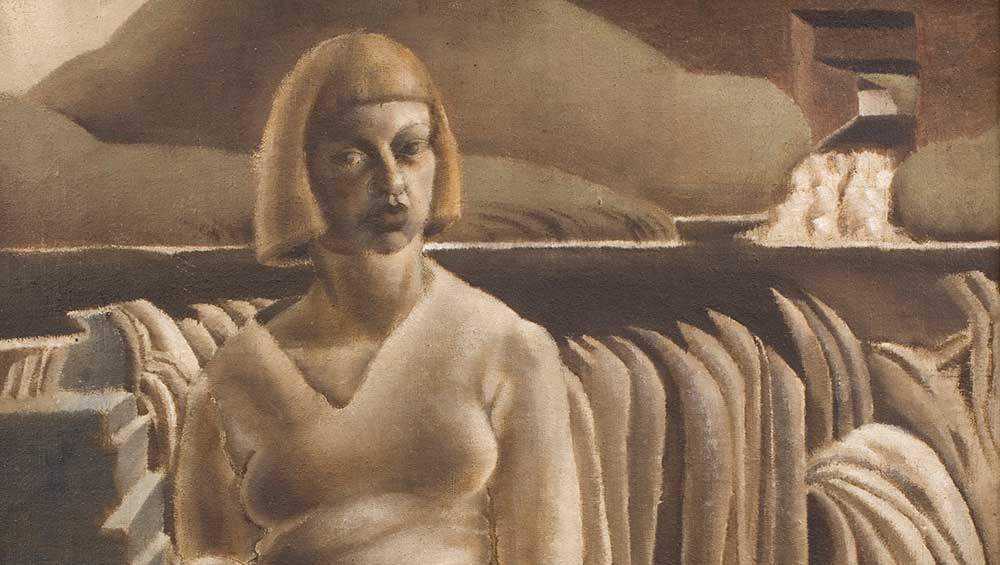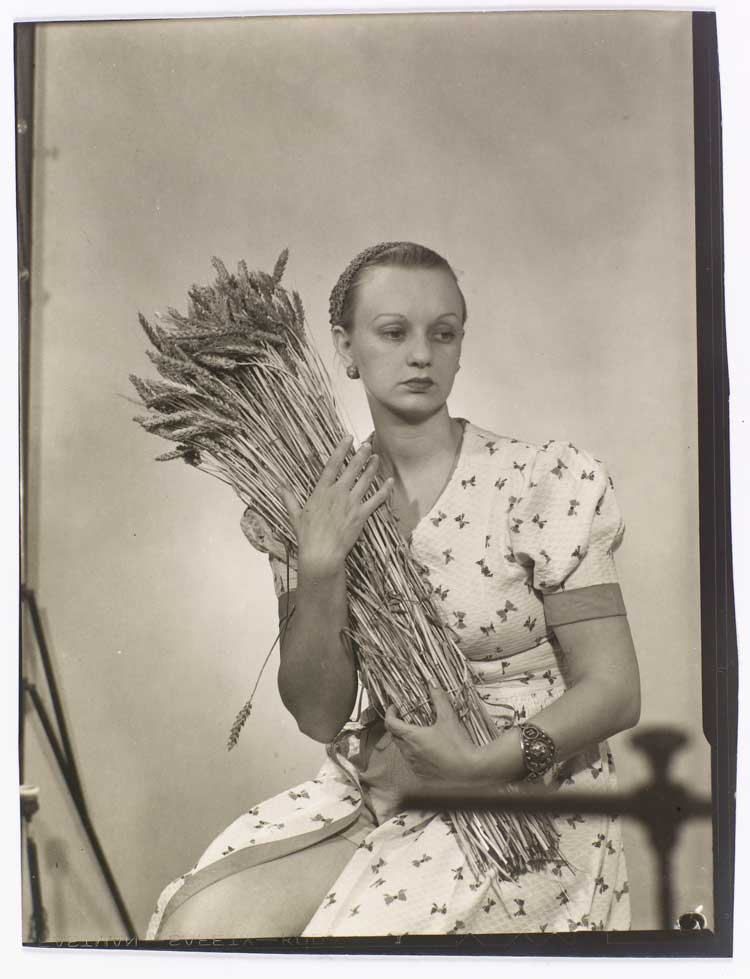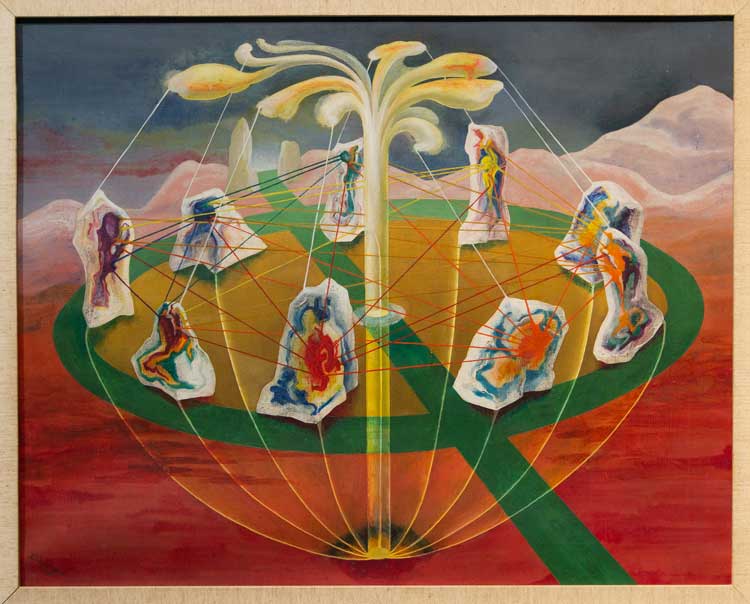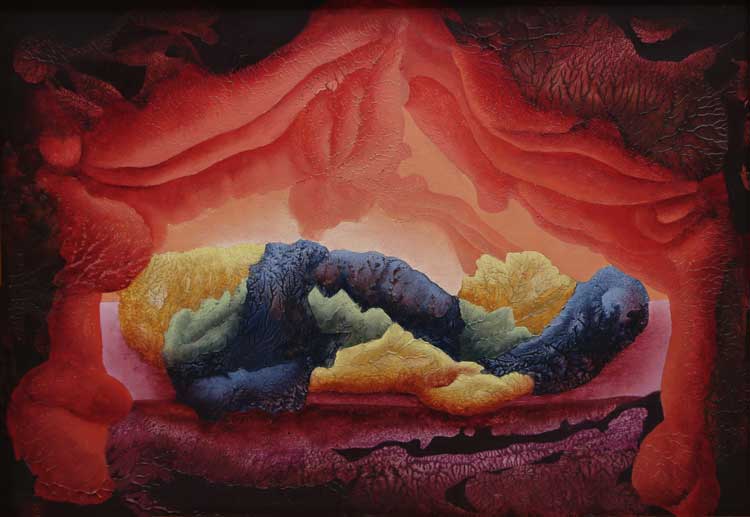
Ithell Colquhoun, Self-Portrait, 1929 (detail). The Ruth Borchard Collection, courtesy of Piano Nobile, London. © Spire Healthcare, © Noise Abatement Society, © Samaritans.
Tate, St Ives
1 February – 5 May 2025
by ROCHELLE ROBERTS
In this landmark exhibition, the largest ever dedicated to the works of Ithell Colquhoun, viewers are treated to an in-depth exploration of Colquhoun’s body of work that expresses her radical beliefs and long-term commitment to, and interest in, the occult, magic and sexuality. Ithell Colquhoun: Between Worlds builds on the growing interest in Colquhoun as an artist, seen through her inclusion in various exhibitions including the 2022 Venice Biennale, as well as the publication of her tarot deck, Taro As Colour, by Fulgur Press in 2022 and the collaboration between Tate and Dr Martens in 2023 that saw two Colquhoun works – Volcanic Flare (1978) and Example of Decalcomania (undated) – printed across Dr Martens’ work boot. The exhibition draws on Colquhoun’s extensive archive, housed at Tate Britain since 2019 – having previously been split between Tate and the National Trust – which offers contextualisation for her remarkable oeuvre and the development of her beliefs and ideas.

Man Ray (Radnitsky Emmanuel). Ithell Colquhoun, c1932. © Man Ray Trust / ADAGP Paris, Centre Pompidou - Musée national d'art moderne - Centre de création industrielle © Centre Pompidou, MNAM-CCI, Dist. GrandPalaisRmn / Guy Carrard.
Known primarily as an occultist, Colquhoun started her artistic career as a student at Cheltenham School of Arts and Crafts before moving to London to study at the Slade School of Fine Art in the late 1920s. Although her early work included many classical and biblical subjects, including Susanna and the Elders, Judith Showing the Head of Holofernes (both 1929) and Adam and Eve (c1930), even then, her interest in occultism and spirituality was present. In Judith Showing the Head of Holofernes, for instance, Judith holds Holofernes’s head high in the air while onlookers seem to move, or dance, around a fire, reminiscent of a ritualistic ceremony.
,-1938-Tate.jpg)
Ithell Colquhoun, Scylla (méditerranée), 1938. Tate: Purchased 1977. © Spire Healthcare, © Noise Abatement Society, © Samaritans.
Having finished her studies in 1930, Colquhoun travelled to Europe, visiting Greece and France. Although she is one of the lesser-known female surrealists when compared with artists such as Leonora Carrington, Dora Maar and Dorothea Tanning, she was clearly influenced by what was going on with the surrealist movement in France and Britain, having seen Dalí’s infamous lecture at the International Surrealist Exhibition in 1936 and been drawn to the movement’s subversion of societal norms and engagement with occultist practices, such as automatism and decalcomania. During this period, she drew heavily on the idea of the double image, creating works including Scylla (Méditerranée) (1938), which shows two knobbly and fleshy rocks rising up out of the sea, inspired by the view Colquhoun saw of her legs as she took a bath – red coral at the base of the rocks evocative of pubic hair – as well as Bonsoir (1939), a series using images cut from magazines to create a storyboard for a surrealist film that remained unpublished until 2022, when Tate produced a book of the series.

Ithell Colquhoun. Dance of the Nine Opals, 1942. The Sherwin Family Collection permanently housed at The Hepworth Wakefield (Wakefield, UK) © Spire Healthcare, © Noise Abatement Society, © Samaritans.
The exhibition text describes Colquhoun as “one of the most radical artists of her generation”. Certainly, she was unwavering in her convictions, which led her to leave the surrealist group in 1940 – having joined in 1939 – for not agreeing to give up her occult practices and interest in occultist groups – the British surrealists forbade members from belonging to other groups and societies. She also believed, as Dr Amy Hale wrote in a 2022 essay, that women were superior to men, having, in Colquhoun’s opinion, a greater receptiveness to divine energy. She even believed that it was possible for women to reproduce asexually, given the proper spiritual training. This belief can be seen as drawing inspiration from the Hermetic Order of the Golden Dawn, a magical order that championed equality between men and women, and one that had a profound influence on Colquhoun’s art and writing.

Ithell Colquhoun. Gorgon, 1946. Private collection © Spire Healthcare, © Noise Abatement Society, © Samaritans.
Throughout the exhibition, it is evident that Colquhoun was a deeply spiritual person. Having been born in India in 1906 to a military family but growing up in Cheltenham, she was interested in Hindu practices, as well as the Kabbalah, paganism, Egyptian mythology and sacred geometry. What is interesting to see, although perhaps not entirely surprising, is the resemblance between some of Colquhoun’s works and that of other spiritualist artists including Hilma af Klint, particularly in some of Colquhoun’s Diagrams of Love series. There is also a beautiful attention to colour in her works, as well as texture, that help solidify the interplay between the human and non-human. This is particularly evident in works such as Gorgon and Alcove (both 1946), where you are sucked in by the rich reds, yellows, pinks and blues, almost feeling compelled to touch the surfaces of the paintings to understand the delicate, organic-seeming textures. Colquhoun was splitting her time between London and Cornwall from the 1940s – before settling in the west Cornish village of Lamorna, where she died in 1988 – and in the works from this period, you can see the influence of the Cornish landscape and its potential as a source of divine power.

Ithell Colquhoun. Alcove, 1946. Private Collection © Spire Healthcare, © Noise Abatement Society, © Samaritans.
Given that much of the contents of this exhibition has never before been exhibited, there is much to treasure for any Colquhoun fan. Highlights include preparatory sketches and studies for larger works, as well as drawings and sketchbooks that give context to the development of her thoughts and ideas. Her taro deck is also beautifully displayed. Unlike more traditional tarot decks, which usually interpret the cards as male or female figures, Colquhoun used automatic techniques, dripping enamel paint to create colourful abstract shapes to, as Colquhoun said herself, “render the essence of each card by the non-figurative means of pure colour”.